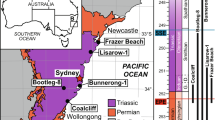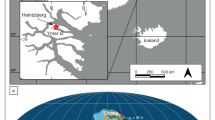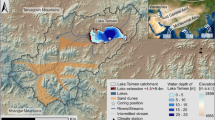Abstract
Possible causes of lake acidification in Britain include acid precipitation, heathland regeneration, afforestation and post-glacial natural acidification (long-term change). In Galloway, south-west Scotland, several lakes with non-afforested catchments have been acidified by approximately 1pH unit since about 18401,2, which clearly precludes long-term change and afforestation as causes of the present acidity, but does not discriminate between the possible effects of heathland regeneration and acid precipitation; it could be argued that a decline in upland farming in this area led to an increase in acid heathland communities capable of promoting lake acidification during this period of time. Here we use pollen analysis to show that there is no evidence for an increase in Calluna vulgaris, the most important heathland species, over the past 200 yr or so, and we substantiate the acid precipitation hypothesis by demonstrating substantial increases of the heavy metals Pb, Cu and Zn in the sediment since about AD 1800.
This is a preview of subscription content, access via your institution
Access options
Subscribe to this journal
Receive 51 print issues and online access
$199.00 per year
only $3.90 per issue
Buy this article
- Purchase on Springer Link
- Instant access to full article PDF
Prices may be subject to local taxes which are calculated during checkout
Similar content being viewed by others
References
Flower, R. J. & Battarbee, R. W. Nature 305, 130–133 (1983).
Battarbee, R. W. Phil. Trans. R. Soc. B305, 451–477 (1984).
Jensen, K. W. & Snekvik, E. Ambio 1, 223–225 (1972).
Rosenquist, I. T. Sci. tot. Envir. 10, 39–49 (1978).
Harriman, R. & Morrison, B. R. S. Hydrobiologia 88, 251–263 (1984).
Nilsson, S. I., Miller, H. G. & Miller, J. D. Oikos 39, 40–49 (1982).
Pennington, W. A. Rep. Freshwat. biol. Ass. 28–46 (1984).
Quennerstedt, N. Acta phytogeogr. suec. 36, 1–208 (1955).
Digerfeldt, G. Folia limnol. scand. 16, 1–104 (1972).
Renberg, I. Early Norrland 9, 113–160 (1976).
Renberg, I. & Hellberg, T. Ambio 11, 30–33 (1982).
Round, F. E. New Phytol. 56, 98–126 (1957).
Mackereth, F. J. H. Proc. R. Soc. B161, 295–309 (1965).
Pennington, W., Haworth, E. Y., Bonny, A. P. & Lishman, J. P. Phil. Trans. R. Soc. B264, 191–294 (1972).
Evans, G. H. & Walker, R. New Phytol. 78, 221–236 (1977).
Engstrom, D. R. & Wright, H. E. in Lake Sediments and Environmental History (eds Haworth, E. Y. & Lund, J. W. G.) (Leicester University Press, 1984).
Battarbee, R. W., Appleby, P. G., Odell, K. & Flower, R. J. Earth Surf. Processes (in the press).
Krug, E. E. & Frink, C. R. Science 221, 520–525 (1983).
Gimmingham, C. H. J. Ecol. 48, 455–483 (1960).
Flower, R. J. & Battarbee, R. W. Br. phycol. Bull. 21, (in the press).
Flower, R. J. & Battarbee, R. W. Working Pap. No. 6 (Palaeoecology Research Unit, University College London, 1983).
Moore, P. D. & Webb, J. A. An Illustrated Guide to Pollen Analysis (Hodder & Stoughton, Dunton Green, 1978).
McVean, D. N. & Lockie, J. D. Ecology and Land Use in Upland Scotland (Edinburgh University Press, 1969).
Forstner, U. Arch. Hydrobiol. 50, 172–191 (1977).
Mason, B. & Moore, C. B. Principles of Geochemistry (Wiley, New York, 1982).
Galloway, J. N., Thornton, J. D., Norton, S. A., Volchok, H. L. & McLean, R. A. N. Atmos. Envir. 16, 1677–1700 (1982).
Davis, R. B., Norton, S. A., Brakke, D. F., Berge, F. & Hess, C. T. in Ecological Impact of Acid Precipitation (eds Drablos, D. & Tollan, A,) (SNSF project, Oslo, 1980).
Rippey, B., Murphy, R. J. & Kyle, S. W. Envir. Sci. Technol. 16, 23–30 (1982).
Wong, H. K. T., Nragu, J. O. & Coker, R. D. Chem. Geol. 44, 187–201 (1984).
Henricksen, A. & Wright, R. F. Wat. Res. 12, 101–112 (1978).
Wright, R. F. & Henricksen, A. Limnol. Oceanogr. 23, 487–498 (1978).
Holdren, G. R., Brunelle, T. M., Matisoff, G. & Wahlen, M. Nature 311, 245–248 (1984).
Wright, R. F. & Henricksen, A. Regional Surv. Lakes Streams Southwestern Scotland (SNSF project IR 72/80, 1980).
Author information
Authors and Affiliations
Rights and permissions
About this article
Cite this article
Battarbee, R., Flower, R., Stevenson, A. et al. Lake acidification in Galloway: a palaeoecological test of competing hypotheses. Nature 314, 350–352 (1985). https://doi.org/10.1038/314350a0
Received:
Accepted:
Issue Date:
DOI: https://doi.org/10.1038/314350a0
This article is cited by
-
Rick Battarbee and his many contributions to palaeolimnology
Journal of Paleolimnology (2013)
-
Why Future Earth needs lake sediment studies
Journal of Paleolimnology (2013)
-
Paleolimnological assessment of limnological change in 10 lakes from northwest Saskatchewan downwind of the Athabasca oils sands based on analysis of siliceous algae and trace metals in sediment cores
Hydrobiologia (2013)
-
Defining reference conditions and restoration targets for lake ecosystems using palaeolimnology: a synthesis
Journal of Paleolimnology (2011)
-
Spatial and Seasonal Variations in Nitrogen Leaching and Acidity across Four Acid-impacted Regions of the UK
Water, Air, and Soil Pollution (2007)
Comments
By submitting a comment you agree to abide by our Terms and Community Guidelines. If you find something abusive or that does not comply with our terms or guidelines please flag it as inappropriate.



